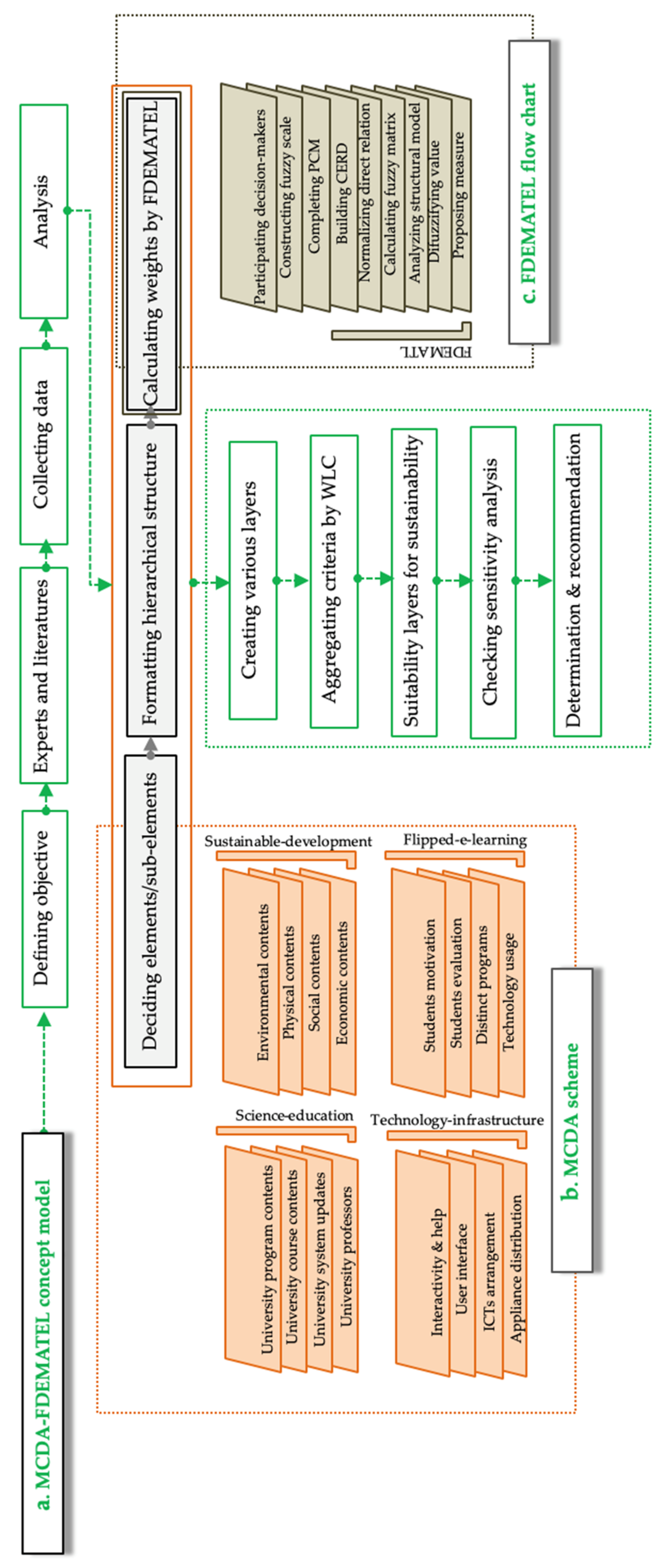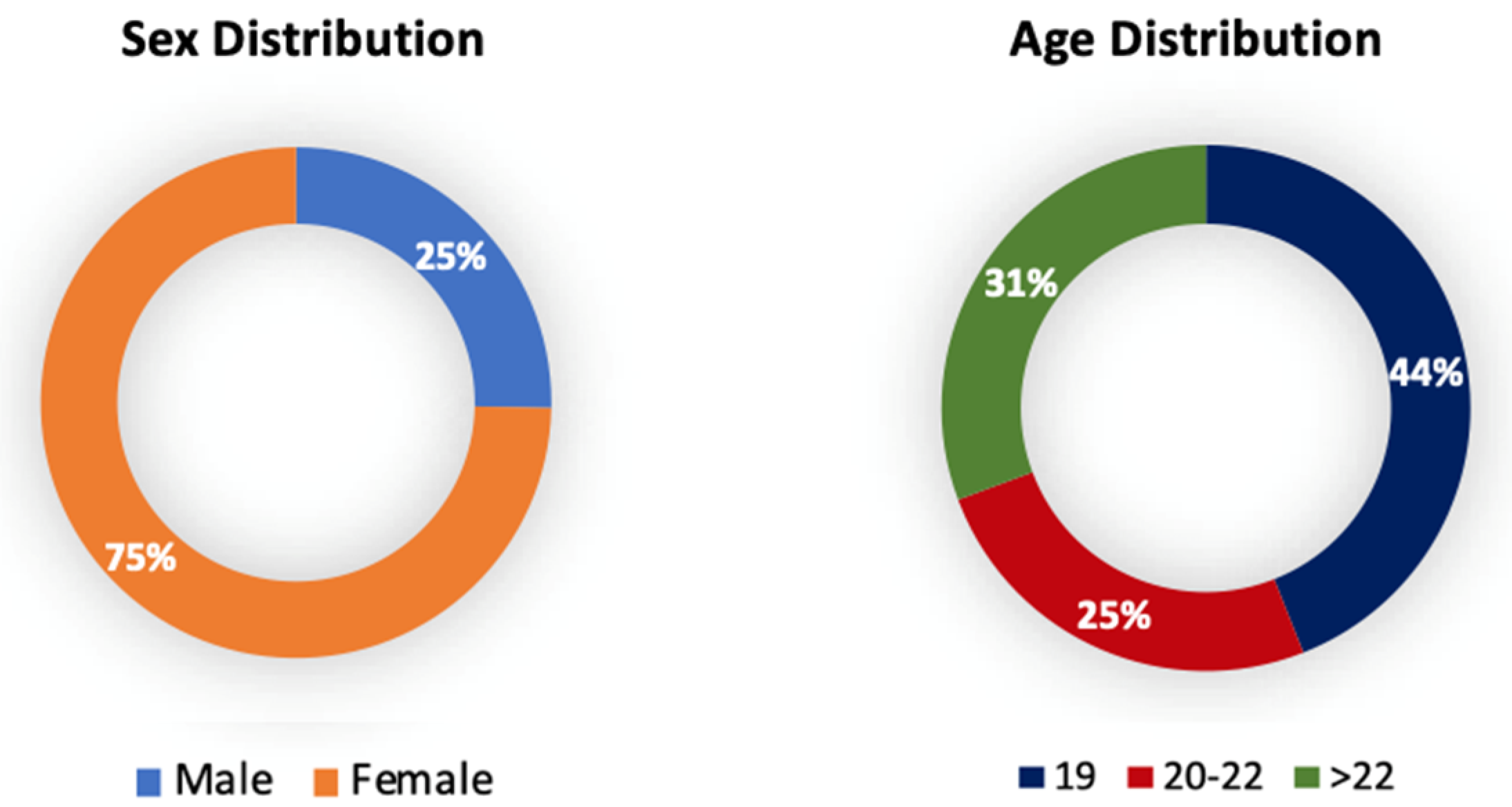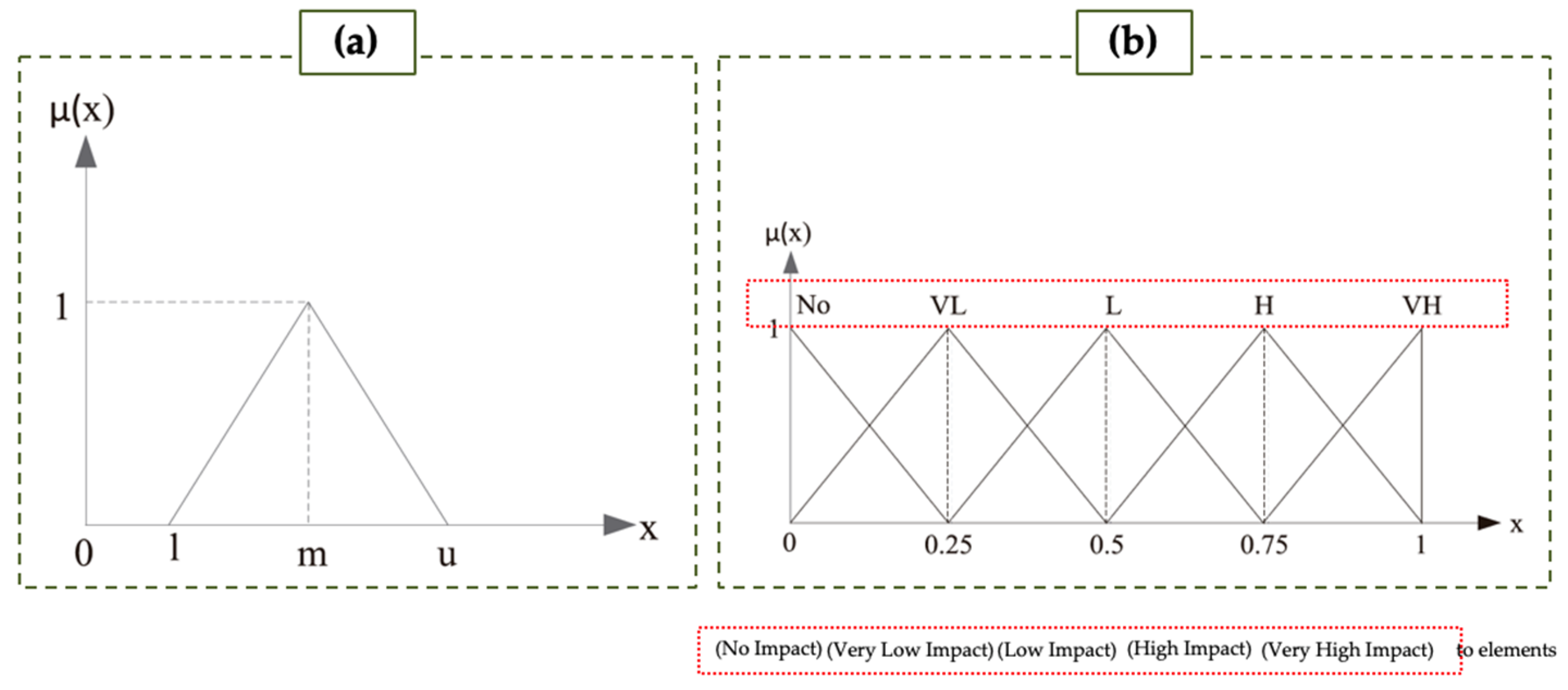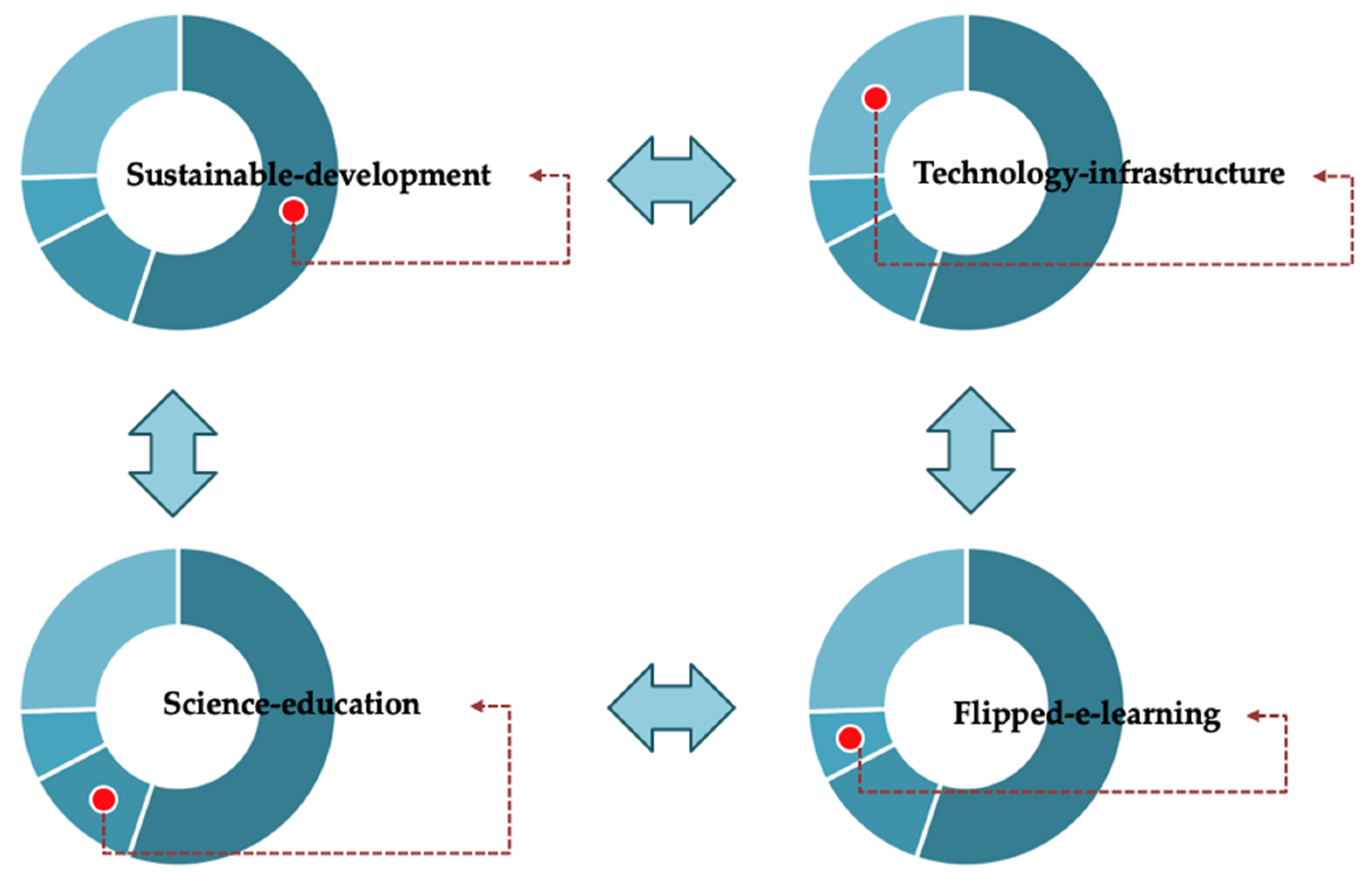Prioritizing Elements of Science Education for Sustainable Development with the MCDA-FDEMATEL Method Using the Flipped E-Learning Scheme
Abstract
:1. Introduction
- RQ 1: Does a MCDA-FDEMATEL method contribute to identify and prioritize elements and sub-elements for science education in sustainable development by flipped e-learning teaching?
- RQ 2: Do the selected elements and sub-elements analyze the prioritization results by WLC and sensitivity-analysis in science education for sustainable development by flipped e-learning teaching?
- RQ 3: Does the suitability implementation show the suitability in science education for sustainable development by flipped e-learning teaching?
2. Materials and Methods
2.1. Targeting Sample
2.2. Elements’ and Sub-Elements’ Description
2.3. MCDA-FDEMATEL Method Application
2.4. WLC and Sensitivity-Analysis
3. Results and Discussion
3.1. Elements’ and Sub-Elements’ Results
3.2. Sensitivity-Analysis with WLC and Results
3.3. Discussion
4. Conclusions
Author Contributions
Funding
Conflicts of Interest
References
- Pavlova, M. Teaching and learning for sustainable development: ESD research in technology education. Int. J. Technol. Des. Educ. 2013, 23, 733–748. [Google Scholar] [CrossRef]
- Segalàs, J.; Ferrer-Balas, D.; Svanstrom, M.; Lundqvist, U.; Mulder, K.F. What has to be learnt for sustainability? A comparison of bachelor engineering education competences at three European universities. Sustain. Sci. 2009, 4, 17–27. [Google Scholar] [CrossRef] [Green Version]
- Sterling, S. Sustainable Education: Re-Visioning Learning and Change; Schumacher Briefings; ERIC: Schumacher, UK, 2001. [Google Scholar]
- UNESCO. UN Decade of Education for Sustainable Development, 2005-2014: The DESD at a Glance; UNESDOC: New York, NY, USA, 2005. [Google Scholar]
- UNESCO. UNESCO Moving Forward the 2030 Agenda for Sustainable Development; UNESDOC: New York, NY, USA, 2017. [Google Scholar]
- Leal Filho, W.; Raath, R.; Lazzarini, B.; Vargas, V.R.; de Souza, L.; Anholon, R.; Quelhas, O.L.G.; Haddad, R.; Klavins, M.; Orlovic, V.L. The role of transformation in learning and education for sustainability. J. Clean. Prod. 2018, 199, 286–295. [Google Scholar] [CrossRef]
- Mezirow, J. Transformative learning: Theory to practice. N. Dir Adult Contin. Educ. 1997, 74, 5–12. [Google Scholar] [CrossRef]
- Thomas, I. Critical thinking, transformative learning, sustainable education, and problem-based learning in universities. J. Transform. Educ. 2009, 7, 245–264. [Google Scholar] [CrossRef]
- Sterling, S.; Thomas, I. Education for sustainability: The role of capabilities in guiding university curricula. Int. J. Innov. Sustain. Dev. 2006, 1, 349–370. [Google Scholar] [CrossRef]
- Sinakou, E.; Boeve.de Pauw, J.; Goossens, M.; Van Petegem, P. Academics in the field of education for sustainable development: Their conceptions of sustainable development. J. Clean. Prod. 2018, 184, 321–332. [Google Scholar] [CrossRef]
- Kajikawa, Y. Research core and framework of sustainability science. Sustain. Sci. 2008, 3, 215–239. [Google Scholar] [CrossRef] [Green Version]
- Bacelar-Nicolau, P.; Caeiro, S.; Martinho, A.; Azeiteiro, U.M.; Amador, F. E-Learning for the environment. The Universidade Aberta (Portuguese open distance university) experience in the environmental sciences Post-Graduate courses. Int. J. Sustain. High. Educ. 2009, 10, 354–367. [Google Scholar] [CrossRef]
- Paechter, M.; Maier, B.; Macher, D. Students’ expectations of and experiences in e-learning: Their relation to learning achievements and course satisfaction. Comput. Educ. 2010, 54, 222–229. [Google Scholar] [CrossRef]
- Eneroth, C. E-Learning for Environment: Improving e-Learning as a Tool for Cleaner Production Education. Ph.D. Thesis, Lund University, Lund, Sweden, 2010. [Google Scholar]
- Gesing, S.; Lawrence, K.; Dahan, M.; Pierce, M.E.; Wilkins-Diehr, N.; Zentner, M. Science gateways: Sustainability via on-campus teams. Future Gener. Comput. Syst. 2019, 94, 97–102. [Google Scholar] [CrossRef]
- Shee, D.Y.; Wang, Y.S. Multi-criteria evaluation of the web-based e-learning system: A methodology based on learner satisfaction and its applications. Comput. Educ. 2008, 50, 894–905. [Google Scholar] [CrossRef]
- Jeong, J.S.; González-Gómez, D.; Cañada-Cañada, F. The study of flipped-classroom for pre-service science teachers. Educ. Sci. 2018, 8, 163. [Google Scholar] [CrossRef]
- Lee, J.; Lee, W. The relationship of e-learner’s self-regulatory efficacy and perception of e-learning environmental quality. Comput. Hum. Behav. 2018, 24, 32–47. [Google Scholar] [CrossRef]
- Arafat, S.; Aljohani, N.; Abbasi, R.; Hussain, A.; Lytras, M. Connections between e-learning, web science, cognitive computation and social sensing, and their relevance to learning analytics: A preliminary study. Comput. Hum. Behav. 2019, 92, 478–486. [Google Scholar] [CrossRef]
- Hansen, D.E. Knowledge transfer in on-line learning environments. J. Mark. Educ. 2008, 30, 93–105. [Google Scholar] [CrossRef]
- Schramm, R.M.; Wagner, R.J.; Werner, J.M. Student perceptions of the effectiveness of web-based courses. NABTE Rev. 2001, 27, 57–62. [Google Scholar]
- Arbaugh, J.B. Virtual classroom versus physical classroom: An exploratory study of class discussion patterns and student learning in an asynchronous internet-based MBA course. J. Manag. Educ. 2000, 24, 213–233. [Google Scholar] [CrossRef]
- Azeiteiro, U.M.; Bacelar-Nicolau, P.; Caetano, F.J.; Caeiro, S. Education for sustainable development through e-learning in higher education: Experiences from Portugal. J. Clean. Prod. 2015, 106, 308–319. [Google Scholar] [CrossRef]
- Garrison, R. Theoretical challenges for distance education in the 21st century: A shift from structural to transactional issues. Int. Rev. Res. Open Distance Learn. 2000, 1, 1–17. [Google Scholar] [CrossRef]
- McVey, M. E-learning and education for sustainability. Int. Rev. Educ. 2016, 62, 117–121. [Google Scholar] [CrossRef]
- Yang, M.; Su, C.; Wang, W. The use of a DANP with VIKOR approach for establishing the model of e-learning service quality. Eurasia J. Math. Sci. Technol. Educ. 2017, 13, 5927–5937. [Google Scholar] [CrossRef]
- Malczewski, J. GIS and Multicriteria Decision Analysis; John Wiley & Sons: New York, NY, USA, 1999. [Google Scholar]
- Zare, M.; Pahl, C.; Rahnama, H.; Nilashi, M.; Mardani, A.; Ibrahim, O.; Ahmadi, H. Multi-criteria decision making approach in e-learning: A systematic review and classification. Appl. Soft Comput. 2016, 45, 108–128. [Google Scholar] [CrossRef]
- Jeong, J.S.; García-Moruno, L.; Hernández-Blanco, J. A site planning approach for rural buildings into a landscape using a spatial multi-criteria decision analysis methodology. Land Use Policy 2013, 32, 108–118. [Google Scholar] [CrossRef]
- Jain, D.; Garg, R.; Bansal, A. A parameterized selection and evaluation of e-learning websites using TOPSIS method. Int. J. Res. Dev. Technol. Manag. Sci. 2015, 22, 12–26. [Google Scholar]
- Islas-Pérez, E.; Pérez, Y.H.; Pérez-Ramírez, M.; García-Hernández, C.F.; Pérez, B.Z. Multicriteria decision making for evaluation of e-learning tools. Res. Comput. Sci. 2015, 106, 27–37. [Google Scholar]
- Büyüközkan, G.; Çifçi, G. A novel hybrid MCDM approach based on fuzzy DEMATEL, fuzzy ANP and fuzzy TOPSIS to evaluate green suppliers. Expert Syst. Appl. 2012, 39, 3000–3011. [Google Scholar] [CrossRef]
- Govindan, K.; Khodaverdi, R.; Vafadarnikjoo, A. Intuitionistic fuzzy based DEMATEL method for developing green practices and performances in a green supply chain. Expert Syst. Appl. 2015, 42, 7207–7220. [Google Scholar] [CrossRef]
- Jeong, J.S.; Ramírez-Góomez, Á. Development of a web graphic model with fuzzy-decision-making Trial and Evaluation Laboratory/Multi-criteria-Spatial Decision Support System (F-DEMATEL/MC-SDSS) for sustainable planning and construction of rural housings. J. Clean. Prod. 2018, 199, 584–592. [Google Scholar] [CrossRef]
- Delivand, M.K.; Cammerino, A.R.B.; Garofalo, P.; Monteleone, M. Optimal locations of bioenergy facilities, biomass spatial availability, logistics costs and GHG (greenhouse gas) emissions: A case study on electricity productions in South Italy. J. Clean. Prod. 2015, 99, 129–139. [Google Scholar] [CrossRef]
- Parkes, M.; Stein, S.; Reading, C. Student preparedness for university e-learning environments. Internet High. Educ. 2014, 25, 1–10. [Google Scholar] [CrossRef]
- Garg, R.; Jain, D. Prioritizing e-learning websites evaluation and selection criteria using fuzzy set theory. Manag. Sci. Lett. 2017, 7, 177–184. [Google Scholar] [CrossRef]
- Mardani, A.; Jusoh, A.; Zavadskas, E.K. Fuzzy multiple criteria decision-making techniques and applications—Two decades review from 1994 to 2014. Expert Syst. Appl. 2015, 42, 4126–4148. [Google Scholar] [CrossRef]
- Kablan, M.M. Decision support for energy conservation promotion: An analytic hierarchy process approach. Energy Policy 2004, 32, 1151–1158. [Google Scholar] [CrossRef]
- Zadeh, L.A. Fuzzy sets. Inform. Control 1965, 8, 338–353. [Google Scholar] [CrossRef] [Green Version]
- Akyuz, E.; Celik, E. A fuzzy DEMATEL method to evaluate critical operational hazards during gas freeing process in crude oil tankers. J. Loss Prev. Proc. 2015, 38, 243–253. [Google Scholar] [CrossRef]
- Meszaros, C.; Rapcsak, T. On sensitivity analysis for a class of decision systems. Decis. Support Syst. 1996, 16, 231–240. [Google Scholar] [CrossRef]
- Jeong, J.S. Design of spatial PGIS-MCDA-based land assessment planning for identifying sustainable land-use adaptation priorities for climate change impact. Agric. Syst. 2018, 167, 61–71. [Google Scholar] [CrossRef]





| Elements: Science-Education | ||||
|---|---|---|---|---|
| Sub-Elements | Element Context | Weight | Name | Validation |
| University program contents | Organization and explanation of university program contents in science education associated with the goals proposed | 0.130 | UPC | CR = 0.089 < 0.1 |
| University course contents | Organization and explanation of university course contents in science education associated with the goals proposed | 0.260 | UCC | |
| University system updates | Organization and explanation of university system updates in science education associated with the goals proposed | 0.050 | USU | |
| University professors | Organization and explanation of university professors in science education associated with the goals proposed | 0.560 | UPR | |
| Elements: Sustainable-Development | ||||
|---|---|---|---|---|
| Sub-Elements | Element Context | Weight | Name | Validation |
| Environmental contents | Organization and explanation of environmental contents for sustainable development associated with the goals proposed | 0.570 | ECO | CR = 0.083 < 0.1 |
| Physical contents | Organization and explanation of physical contents for sustainable development associated with the goals proposed | 0.250 | PCO | |
| Social contents | Organization and explanation of social contents for sustainable development associated with the goals proposed | 0.120 | SCO | |
| Economic contents | Organization and explanation of economic contents for sustainable development associated with the goals proposed | 0.060 | EMO | |
| Elements: Technology-Infrastructure | ||||
|---|---|---|---|---|
| Sub-Elements | Element Context | Weight | Name | Validation |
| Interactivity and help | Organization and explanation of interactivity and help in technology and infrastructure associated with the goals proposed | 0.070 | IHE | CR = 0.059 < 0.1 |
| User interface | Organization and explanation of user interface in technology and infrastructure associated with the goals proposed | 0.120 | UIN | |
| ICTs arrangement | Organization and explanation of ICTs arrangement in technology and infrastructure associated with the goals proposed | 0.540 | IAR | |
| Appliance distribution | Organization and explanation of appliance distribution in technology and infrastructure associated with the goals proposed | 0.250 | ADI | |
| Elements: Flipped-e-Learning | ||||
|---|---|---|---|---|
| Sub-Elements | Element Context | Weight | Name | Validation |
| Students motivation | Organization and explanation of students’ motivation in flipped-e-learning associated with the goals proposed | 0.240 | SMO | CR = 0.091 < 0.1 |
| Students evaluation | Organization and explanation of students’ evaluation in flipped-e-learning associated with the goals proposed | 0.050 | SEV | |
| Distinct programs | Organization and explanation of distinct programs in flipped-e-learning associated with the goals proposed | 0.570 | DPR | |
| Technology usage | Organization and explanation of technology usage in flipped-e-learning associated with the goals proposed | 0.140 | TEU | |
| Nine Points Assessment Scale in PCM | ||||||||||||||||
|---|---|---|---|---|---|---|---|---|---|---|---|---|---|---|---|---|
| Less important | More important | |||||||||||||||
| 1/9 | 1/8 | 1/7 | 1/6 | 1/5 | 1/4 | 1/3 | 1/2 | 1 | 2 | 3 | 4 | 5 | 6 | 7 | 8 | 9 |
| Extremely | Very-Strongly | Strongly | Moderately | Equally | Moderately | Strongly | Very-Strongly | Extremely | ||||||||
| Implementation | Science-Education | Sustainable-Development | Flipped-E-Learning | Technology-Infrastructure |
|---|---|---|---|---|
| I. Equal weights to elements | 0.250 | 0.250 | 0.250 | 0.250 |
| II. Priority to science-education | 0.500 | 0.167 | 0.167 | 0.167 |
| III. Priority to sustainable-development | 0.167 | 0.500 | 0.167 | 0.167 |
| IV. Priority to flipped-e-learning | 0.167 | 0.167 | 0.500 | 0.167 |
| V. Priority to technology-infrastructure | 0.167 | 0.167 | 0.167 | 0.500 |
| VI. Priority to decision-makers | 0.120 | 0.540 | 0.070 | 0.250 |
© 2019 by the authors. Licensee MDPI, Basel, Switzerland. This article is an open access article distributed under the terms and conditions of the Creative Commons Attribution (CC BY) license (http://creativecommons.org/licenses/by/4.0/).
Share and Cite
Jeong, J.S.; González-Gómez, D.; Cañada-Cañada, F. Prioritizing Elements of Science Education for Sustainable Development with the MCDA-FDEMATEL Method Using the Flipped E-Learning Scheme. Sustainability 2019, 11, 3079. https://doi.org/10.3390/su11113079
Jeong JS, González-Gómez D, Cañada-Cañada F. Prioritizing Elements of Science Education for Sustainable Development with the MCDA-FDEMATEL Method Using the Flipped E-Learning Scheme. Sustainability. 2019; 11(11):3079. https://doi.org/10.3390/su11113079
Chicago/Turabian StyleJeong, Jin Su, David González-Gómez, and Florentina Cañada-Cañada. 2019. "Prioritizing Elements of Science Education for Sustainable Development with the MCDA-FDEMATEL Method Using the Flipped E-Learning Scheme" Sustainability 11, no. 11: 3079. https://doi.org/10.3390/su11113079
APA StyleJeong, J. S., González-Gómez, D., & Cañada-Cañada, F. (2019). Prioritizing Elements of Science Education for Sustainable Development with the MCDA-FDEMATEL Method Using the Flipped E-Learning Scheme. Sustainability, 11(11), 3079. https://doi.org/10.3390/su11113079







